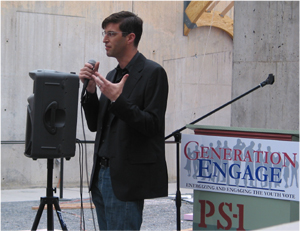
Michael Arad Speaking at the Generation Engage Event at P.S.1 in Long Island City. (Photo by Maurice Pinzon)
Mr. Arad discussed these issues at P.S.1 in Long Island City, at an event sponsored by Generation Engage. The organization aims to provide non-college-educated young adults with avenues to activism. In introductory remarks, Mr. Arad described the inspiration for his winning memorial design.
Mr. Arad said: “I remember going to Washington Square Park a few nights after September 11 and standing there around that fountain in the middle of the park about 2 in the morning. I came there by myself and there were probably around a dozen people standing around that fountain, and I felt this strong sense of community ”” that we were there together. We didn’t say anything. No words were spoken.”
It was the first time he had felt such a sense of community, especially in a city that he described as “a very easy city to sort of be in, but not of,” where he said “you can sort of observe everything and keep a nice cool distance.”
“That was my feeling about New York, or at least how it was four years ago,” Mr. Arad reflected.
Back then, Mr. Arad said he flew an American flag ”” something he thought he would never do, having lived in so many different places without feeling a deep connection to any of them.
Indeed, many New Yorkers experienced those same emotions in the days following September 11, 2001, posting American flags outside their windows or by their doors as if temporarily adopting the American flag as a symbol for New York City.
A group of about 150 young people listened as Mr. Arad told them that he eventually settled on an “image in my mind of these two voids in the Hudson River, the water just sort of falling into them, and they would never fill up.”
He added, “I just imagined these two empty vessels”¦ and for me they were a way of conveying the sense of absence and loss, which I felt at the time.”
After the architectural contest for the memorial was announced, Mr. Arad gained a new focus, forced to think of how that image could be transposed onto the grounds of the World Trade Center site.
Mr. Arad said in his mind, it was essential to have the falling water “come down below ground to these galleries, which would surround the pools. And to me this space is so important because what I wanted to do is capture what I felt here in New York after September 11 ”” to create a place where people could come together, could face the names of all these people who died here and not feel alone as they were doing it, but feel that they were part of something greater.”
Last Tuesday, Governor George E. Pataki and Mayor Michael R. Bloomberg sent out a news release without the usual grandiose public announcement to accompany it. Instead, this announcement about the site’s development essentially reversed the elements in Mr. Arad’s memorial design.
Mayor Bloomberg’s vision and words regarding the rebuilding of the World Trade Center site, and downtown Manhattan in general, always have been more practical than Governor Pataki’s. In December 2002, Mayor Bloomberg outlined a comprehensive plan to revitalize downtown Manhattan that included, transportation, residential, open space and business components. But this vision and the necessary focus was soon lost as the Bloomberg administration ceded power to Governor Pataki and as the mayor and Deputy Mayor Daniel L. Dockoroff began spending more time worrying about bringing the Olympics to New York City in 2012.
The Lower Manhattan Development Corporation (LMDC), the agency tasked with rebuilding and revitalizing the World Trade Center site and downtown Manhattan, has functioned like a staffing temp agency and it became a decision-making bureaucratic black hole as evidenced by the various false starts in the rebuilding efforts. In addition to the memorial redesign, to name just a few problems, we have the redesign of the Freedom Tower, the problematic deconstruction of the Deutsche Bank site, the Larry Silverstein power struggle with the mayor and governor, the anemic fundraising results for the memorial and the controversy over the Cultural Center’s programming.
Only now Mayor Bloomberg appears to be gaining greater influence over the downtown redevelopment effort as Governor Pataki’s time in office runs out and as the governor feels compelled to install a symbolic memorial cornerstone before increasing his presidential campaign efforts in Iowa.
The World Trade Center’s memorial mission statement on the LMDC website reads in part: “Remember and honor the thousands of innocent men, women, and children murdered by terrorists”¦.respect this place made sacred through tragic loss”¦recognize the endurance of those who survived, the courage of those who risked their lives to save others, and the compassion of all who supported us in our darkest hours”¦.may the lives remembered, the deeds recognized, and the spirit reawakened be eternal beacons”¦”.
Bold language has succumbed to a reassessment by Frank J. Sciame, a construction executive commissioned by LMDC to reduce the costs of the memorial. In his report to LMDC, Mr. Sciame cites the “Reduction of costs through traditional value engineering methods.” For a definition of value engineering, see: Value Engineering
